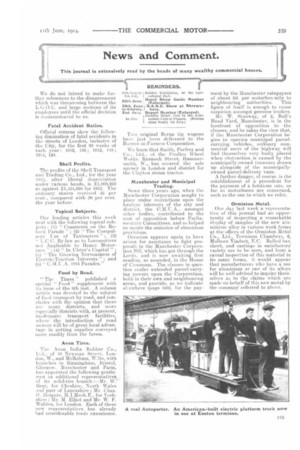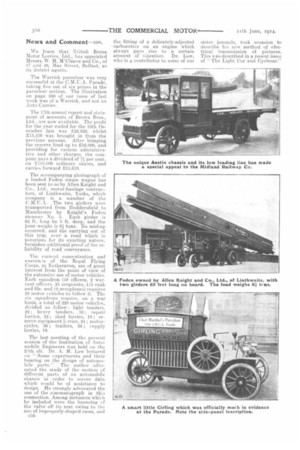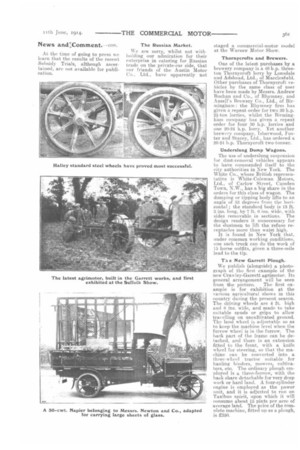News and Comment.
Page 15

Page 16

Page 17

If you've noticed an error in this article please click here to report it so we can fix it.
This journal is extensively read by the heads of many wealthy commercial houzes.
We do not intend to make further Yelievences to the disagreement which was threatening between the L.G.O.C. and large sections of its employees until the official decision is communicated to us.
Fatal Accident Ratios.
Official returns show the following diminution of fatal accidents in the. streets of London, inclusive of the City, for the first '20 weeks of each year : 1912, 155; 1913, 143; 1914, 120.
Shell Profits.
The profits of the Shell Transport and Trading Co., Ltd., for the year ion,after liberal depreciation under various heads, is £1,800,260 as against £1,454,098 for 1912. The ordinary shares received 35 per cent., compared with 30 per cent. the year before.
Topical Subjects.
Our leading articles this week rival with the following topical subjects: (1) " Comments on the Record Parade " ; (2) " The Compulsory Use of Taximeters " (3) " I.C.C. By-law as to Locomotives not Applicable to He.a.vy Motorcars ; (4) " In Ulster's Capital (5) " The Crowing Nervousness of Electric-Traction Interests " ; and (e) " C.MX. A. 1915 Parades."
Food by Road.
"The Times" published a special " Food" supplement with its issue of the 8th inst. A column article was devoted to the subject of food transport by road, and concludes with the opinion that there a re many districts, and more especially districts with, at present, dcquate transport facilities, where the introduction of road motors will be of great local advantage in getting supplies conveyed more readily from the farms.
Avon Tires.
The Avon India Rubber Co., Ltd., of 19 Newman Stre4, London, W., and Melksham, W:lts, with branches in Birmingham, Bristol, Glasgow. Manchester and Paris, has appointed the following gentlemen as additional representatives. of its solid-tire branch :—Mr. W. Bray, for Cheshire, North Wales and part of Lancashire ; Mr. Chas. P. llolgate. M.I.Mech.E., for Yorkshire Mr. M. Elliot and Mr. W. F. Walden. for London. Each of these new representatives has already had considerable trade experience.
Two original Berna tip wagons hare just been delivered to the Barrow-in-Furness Corporation.
We learn that Smith, Ifarfrey and Co., Ltd., of the Pimlico Wheel Works. Rannoch Street, Hammersmith, W., has secured the sole. agency in London and district for the Clayton steam tractor.
Manchester and Municipal Trading. Some three years ago, when the Manchester Corporation sought to place undue restrictions upon the haulage interests of the city and district, the C.M.U.A., amongst other bodies, contributed to tile cost of opposition before Parliamentary Committees, and so helped to secure the omission of obnoxious provisions.
Occasion appears again to have arisen for assistance to fight proposals in the Manchester Corporation Bill, which has got through the Lords, and is now awaiting first reading, as amended, in the House of Commons. The clauses in question confer extended parcel-carrying powers upon the Corporation, both in their own and neighbouring areas, and provide, as we indicate eFewhere (page 346), for the pay
ment by the Manchester ratepayers of about 2d. per motorbus-mile to neighbouring authorities. This figure of itself is enough to rouse suspicion amongst genuine traders.
Mr. W. Stanway, of 2, Bull's Head 'Yard, Manchester, is in the forefront of opposition to the clauses, and he takes the view that, if the Manchester Corporation begins to operate municipal parcelcarrying vehicles, ordinary commercial users of the highway will find themselves very badly placed when obstruction is caused by the municipally-owned tramcars drawn up :alongside of the municipallyowned parcel-delivery vans.
A further danger, of course, is the establishment of a precedent for the payment of a fictitious rate, so far as motorbuses are concerned, such as the one to which we refer.
Ormiston Metal.
One day last week arepresenta
tive of this journal had an opportunity of inspecting a remarkable display of samples of the new aluminium alloy in various work forms at the offices of the Ormiston Metal Co., Ltd., Terminus Chambers, 6,
Holborn Viaduct, E.C. Rolled bar, sheet, and castings in satisfactory variety are to be seen, and from a casual inspection of this material in its many forms, it would appear that manufacturers who have a use for aluminium or one of its alloys will he well advised to inquire themselves as to the claims which aro made on behalf of this new metal by the companY referred to above. We learn that British Berna Motor Lorries, Ltd., has appointed Messrs. W. M. M'Cleave and Co., of 47 and 49, May Street, Belfast, as its district agents.
The Warrick parcelcar was very successful at the C.M.L".A. Parade, taking five out of six prizes in the parcelcar section. The illustration on page 330 of our issue of last week was of a Warrick, and not an Auto-Carrier.
The 17th annual report and statement of accounts of Brown Bros., Ltd., are now available. The profit for the year ended for the 19th December last was 126,939. whilst £15,430 was brought in from the previous account. After bringing the reserve fund up to £50,000, and providing for various administrative and other charges, the company pays a dividend of 1 per cent. on 1150,000 ordinary shares, and carries forward £15,619.
The accompanying photograph of a loaded Foden steam wagon has been sent to us by Allen Knight and Co., Ltd., motor-haulage contractors, of Linthwaite, Yorks, which company is a member of the C. M.U.A. The two girders were transported from Huddersfield to Manchester by Knight's Foden steamer No. 5. Each girder is 62 ft. long by 5 ft. deep, and the joint weight is 6i tons. No mishap occurred, and the carrying out of this trip, over a, road which is notorious for its exacting nature, furnishes additional proof of the reliability of road conveyance.
The current concentration and exereis.n of the Royal Flying Corps, at Netheravon, are of great interest from the point of view of the extensive use of motor vehicles. Each squadron (19 officers, 2 warrant officers, 21 sergeants,-115 rank and file, and 12 aeroplanes) requires 38 motor vehicles to follow it. The six squadrons require, on a war basis, a total of 228 motor vehicles, divided as follow : light tenders, 42 ; heavy tenders, 36; repair lorries, 24 ; shed lorries, 18; reserve-equipment Ii. rries, 24; motorcycles, 36 ; trailers, 36 ; supply lorries, 12.
The last .meeting of the present session of the Institution of Automobile Engineers was held on the 27th td t. Dr. A. M. Low lectured on " Some experiments and their bearing on the design of automobile parts." The author advocated the study of the motion of different parts of an automobile chassis in order to secure data which would be of assistance to design. He strongly advocated the use of the cinematograph in this connection. Among instances which he included were the bouncing of the valve off its seat owing to the use of improperly-shaped earns, and c:16
the fitting of a delicately-adjusted carburetter on an engine which always gaverise to a certain amount of vibration. Dr. Low, who is a contributor to some of our sister journals, took occasion to describe his new method of electrical transmission of pictures. This was described in a recent issue of "The Light Car and Cyclecar.'
At the time of going to press we learn that the results of the recent Subsidy Trials, although ascertained, are not available for publication. The Russian Market.
We are sony, whilst not withholding our admiration for their enterprise in catering for Russian trade on the private-car side, that our friends of the Austin Motor Co., Ltd., have apparently not
staged a commercial-motor model at the Warsaw Motor Show.
Thornycrofts and Brewers.
One of the latest purchases by a brewery company is a 40 h.p. threeton Thorny-croft lorry by Lonsdale and Adshead, Ltd., of Macclesfield. Other purchases of Thornycroft vehicles by the same class of user have been made by Messrs. Andrew Buchan and Co., of Rhytnney, and AnselI's Brewery Co., Ltd., of Birmingham : the Bhymney firm has given a repeat order for two 30 h.p. 2i-ton lorries, whilst the Birmingham company has given a repeat order for four 30 h.p. lorries and one 20-24 h.p. lorry. Yet another brewery company, Isherwood, Foster and Stacey, Ltd., has ordered a 20-24 h.p. Thornycroft two-tonner.
Unclerslung Dump Wagons.
The use of underslung suspension for dust-removal vehicles appears to have commended itself to the city authorities in New York. The White Co., whose British representative is White-Coleman Motors, Ltd., of Carlow Street, Camden Town, N.W., has a big share in the orders for this class of wagon. The dumping or tipping body lifts to an angle of 53 degrees from the horizontal; the standard body is 13 ft. 3 ins, long, by 7 ft. 6 ins, wide, with sides removable in sections. The design renders it unnecessary for the dustmen to lift the refuse receptacles more than waist high.
It is found in New York that, under common working conditions. one such truck can do the work of 15 horse outfits, given a three-mile lead to the tip.
The New Garrett Plough.
We publish (alongside) a photograph of the first example of the new Crawley-Garrett a,grimotor. Its general arrangement will be seen
from tlhe picture. The first example is for exhibition at the various agricultural shows in this country during the present season. The driving wheels are 4 ft. high and 8 ins, wide, and made to take suitable spuds or grips to allow travelling on uncultivated ground. The land wheel is adjustable so as to keep the machine level when the furrow wheel is in the furrow. The back part of the frame can be detached, and there is an extension fitted to the front, with. a knife wheel for steering, so that the machine can be converted into a three-wheel tractor suitable for hauling binders, mowers, cultivators, etc. The ordinary plough employed is a three-furrow, with the back share detachable for very deep work or hard land. A four-cylinder engine is employed as the power unit: and it is adjusted to run on Taxibus spirit, upon which it will consume about 15 pints per acre of average land. The price of the complete machine, fitted up as a plough, is :2350.

























